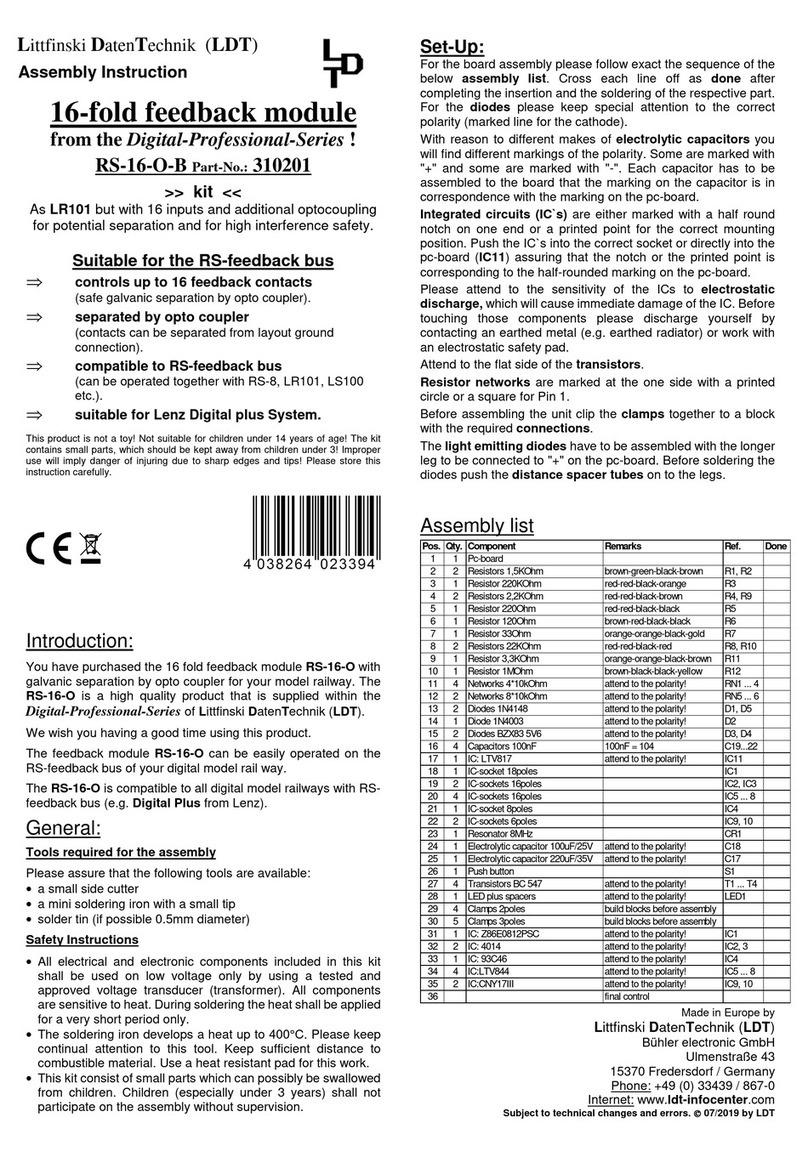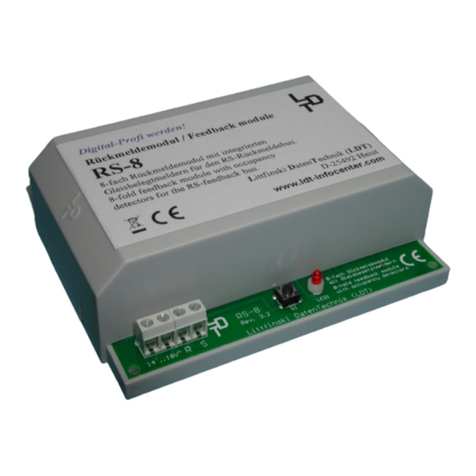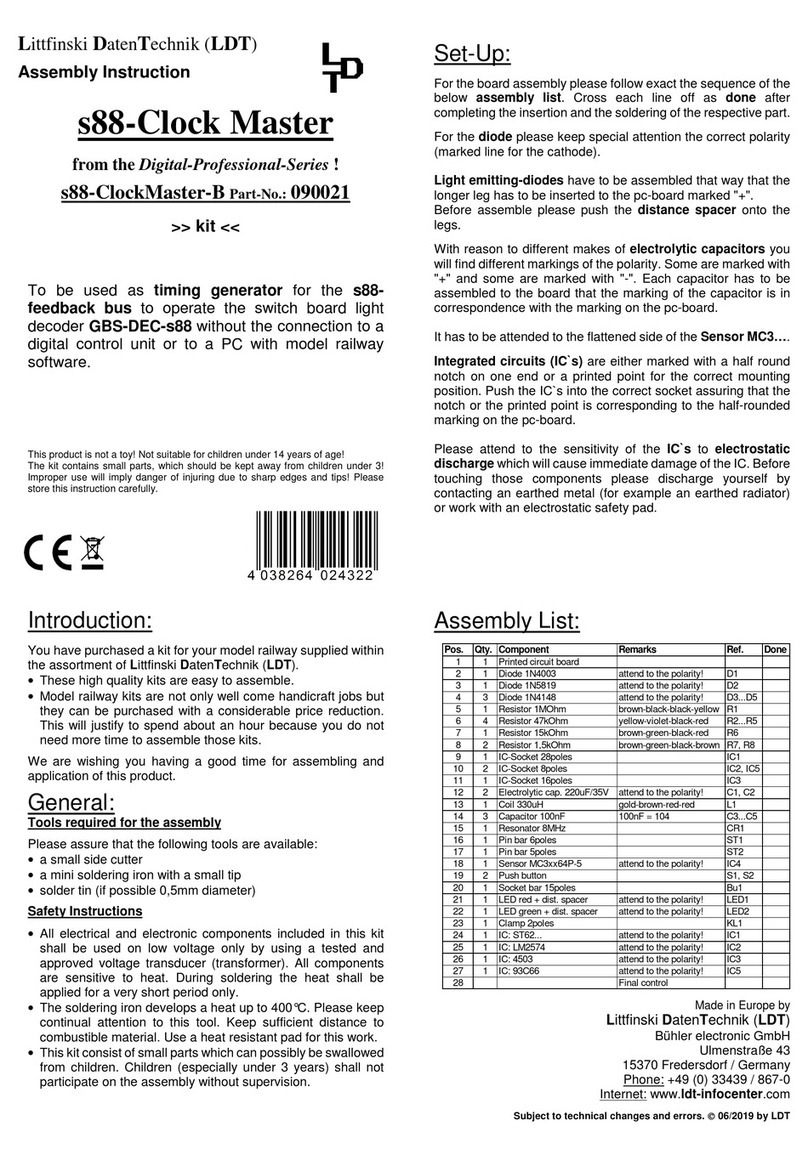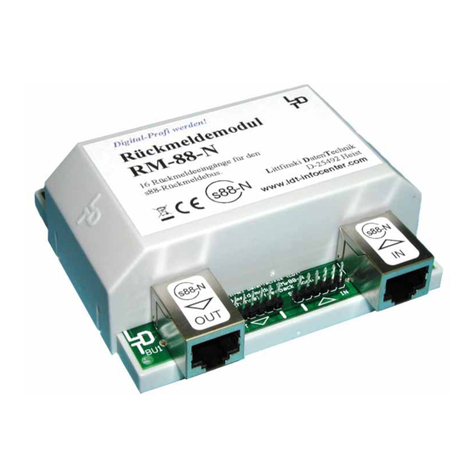
Assigning addresses of the feedback module
RS-8:
Addresses for feedback tasks at the Digital plus System are
located in the area from 1to 128. To assure a definite feedback
each address can only be assigned once.
In addition the feedback address area is subdivided. Area 1to 64
is reserved for turnout decoders with feedback function.
Feedback modules like the RS-8 should therefore be addressed
in the area between 65 and 128 to avoid overlapping.
Therefore the LDT RS-8 feedback module is delivered with the
default address 65.
To change the address the RS-8 is equipped with a
programming key S1 and a red light diode. By pushing the
programming key once the diode will flash which means that
the RS-8 is ready for programming.
Programming mode will only work, if the Jand Kclamps at IN1
and IN2 of the 20 pole clamp are properly connected to the
digital circuit (see description above).
While the diode is flashing, you can assign the feedback address
with the hand controller LH100. Press the keys >F< and >5< to
get into the mode “magnet accessories”. Enter the requested
feedback address now (e.g. >7< >4< for 74) and press
>ENTER<. By pressing key >+< or >-< the feedback address
input will be saved. The diode will switch off if the module has
accepted the address. The RS-8 is now in operation mode again.
By pressing the keys >ESC<, >F< and >6< on the LH100 you will
get into the mode “feedback”. Enter the previously assigned
address (e.g. >7< and >4< for 74) and press >ENTER<.
If the RS-8 was connected properly to the RS-feedback bus, the
display of the hand control LH100 will show a “b” left below the
assigned feedback address.
When there was no feedback information received from the RS-
8the display of the LH100 shows a hyphen behind the feedback
address. Check the connection of your RS-8 and repeat
programming as described above.
If you wish to control the module with a renewed model of the
manual controller or with another central unit with R/S interface,
you should read the respective operation manual at the section
“Turnout / Signal settings” respectively “Feedback reports”.
Connecting a track section:
Following figure shows how to connect the feedback module
RS-8 with a track.
The monitored isolated track sections will get the digital current
supply via clamp 1 to 8. It is required that one rail is isolated.
Detailed Sample Connections are available on our web site
(www.ldt-infocenter.com) under “Downloads”.
For assembling 2 different power booster (LZV100 / LV101 /
LV102 / LV200) the RS-8 is divided into 2 x 4 track occupancy
controller. The output 1 to 4 gets the supply via the input
clamps IN1 and the output 5 to 8 via IN2. Therefore, it is simply
possible to monitor up to 4 track sections in a reversing loop.
For this application a reverse loop module (e.g. LK100) has to
be assembled between the power booster and the input clamp
IN1.
Please pay attention to the identification J and Kat the clamps
IN1 and IN2 as well as on the power booster.
To avoid short circuits when locomotives are crossing the
transitions of each detected track, the sequence of connecting
the tracks has to be always strictly followed.
RS-8
digital current from
command station
or booster
Digitalstrom von
Steuereinheit oder
Booster
Normalgleis
standard track Überwachte Gleisbereiche
monitored track areas
KL7 KL8
Vom Modellbahntrafo
RS-Rückmeldebus
RS-feedback bus
From transformer
1 2 3 4
IN1 IN2
K J K J
5 6 7 8
Therefore, the OUTPUT clips are marked with a continuous and
a non-continuous line. Cables marked with Jalways connected
to the clips with a continuous line.
In case of a short circuit when crossing the transition (control unit
will switch to STOP) please change the cables at the respective
OUTPUT clamps of the monitored section.
Anti-interference capacitor can lead to an erroneous occupied
detection of the track and should therefore not be used within the
monitored track sections.
If you apply electrical resistant coating to the axles of your
trains, you should measure the resistance value with a Multi-
meter after complete drying.
A resistance between 5and 10 KOhm will guarantee a safe
monitoring by the occupied track detection of the feedback
modules RS-8.
Customary used resistance axles with a resistance value of
18k Ohm will just be monitored, provided that the rails are very
clean and the railway coaches have a sufficient contact to the
rails. In such case it will be recommended, to fit two resistance
axles to the coach to receive a total resistance value of about
9k Ohm. This will assure a save monitoring even when the rails
are not perfect clean.
Trouble shooting:
What to do if something is not working as described above?
If you have purchased the RS-8 as a kit, please carefully check
all parts and all soldered joints.
Important for a correct feedback report is: It is absolutely
required that both inputs (IN1 and IN2) will receive the supply of
digital current.
Please test the detecting function of the modules first before
connecting it to the tracks.
To do this you can use a resistor (several of hundred Ohms) or a
model railway lamp which will simulate the occupied situation on
each clamp.
Without resistor or lamp the detection of the input should be
identified as “free”. With a resistor or lamp your digital control unit
or PC should show an “occupied” situation.
Made in Europe by
Littfinski DatenTechnik (LDT)
Bühler electronic GmbH
Ulmenstraße 43
15370 Fredersdorf / Germany
Phone: +49 (0) 33439 / 867-0
Internet: www.ldt-infocenter.com
Subject to technical changes and errors. 08/2022 by LDT
Lenz and Digital plus are registered trademarks.
























